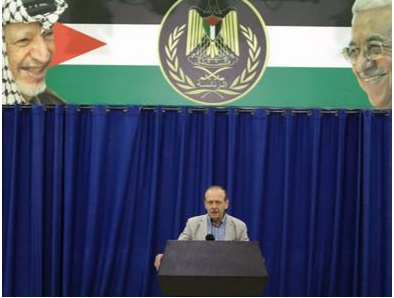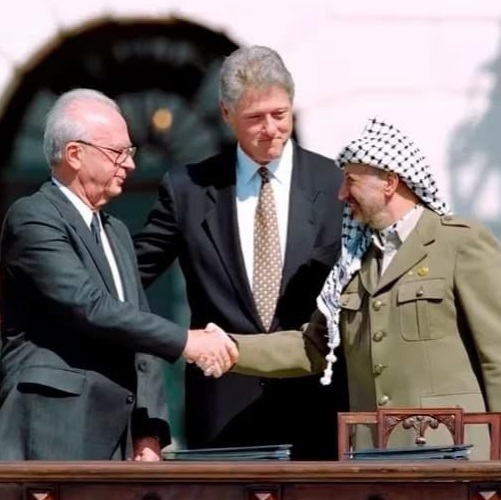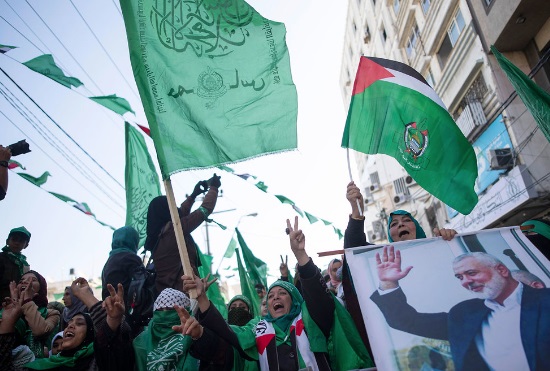Lexicon of the Hamas Organization
Palestine Liberation Organization - PLO

PLO. Credit: Palestinian Liberation Organization FB page.
The Early Years and Ideological Foundations
Founded in 1964, the PLO emerged as a pan-Arabist and nationalist movement aiming to establish a Palestinian state. Initially, it was under significant influence from Arab states, particularly Egypt. PLO’s charter called for the liberation of Palestine and the elimination of Zionism, reflecting the heightened tensions of the period.
Major Conflicts with Israel

Yasser Arafat. Credit: ‘חדשות 13’ FB page.
In its early years, the PLO was involved in numerous armed conflicts with Israel. The organization’s militant wing, Fatah, led by Yasser Arafat, conducted guerrilla warfare and terrorist attacks against Israeli targets. The 1970s and 1980s saw an escalation in violence, with notable incidents such as the 1972 Munich Olympics massacre, bringing the PLO’s agenda to the global stage.
The 1982 Lebanon War marked a significant turn in the PLO’s history. Israel’s invasion of Lebanon aimed to eradicate the PLO’s military presence there. The war culminated in the PLO’s expulsion from Lebanon, forcing its leadership to relocate to Tunisia. This event signaled a shift in the PLO’s strategy from armed struggle to political engagement.
From Armed Struggle to Political Negotiations
The late 1980s and 1990s witnessed a transformation in the PLO’s approach. The First Intifada (1987-1993), a Palestinian uprising against Israeli occupation, brought the Palestinian struggle to international attention. In response, the PLO began to consider diplomatic channels to achieve its goals.
This shift was epitomized by the Oslo Accords, signed in 1993. These agreements, negotiated directly between the PLO and Israel, marked the first time the two sides engaged in direct, face-to-face negotiations. Under the Oslo Accords, the PLO recognized the State of Israel and renounced terrorism, while Israel acknowledged the PLO as the legitimate representative of the Palestinian people.
Leadership and Internal Dynamics
The PLO’s leadership played a crucial role in its evolution. Yasser Arafat, the most prominent leader, was at the helm for decades. His leadership style and decisions, particularly his involvement in peace talks, shaped the organization’s path.
Legacy and Contemporary Relevance
Today, the PLO remains a significant political entity, though its influence has waned due to internal Palestinian divisions and the rise of other groups like Hamas. Its legacy is complex: on the one hand, it brought international attention to the Palestinian cause; on the other, its history of violence and terrorism has left deep scars.
Conclusion
The history of the PLO is intertwined with the broader narrative of the Arab-Israeli conflict. Its journey from armed struggle to political engagement reflects the evolving dynamics of the region. While peace remains elusive, understanding the PLO’s history is crucial in comprehending the complexities of the ongoing conflict.
Lexicon of the Hamas Organization
The Oslo Accords

Israel PM Rabin, PLO president Araffat and USA President Bill Clinton signing Oslo Accords. Credit: ‘History in Pictures’ FB page.
The Oslo Accords, a cornerstone in the history of the Israeli-Arab conflict, represent a pair of pivotal agreements between Israel and the Palestine Liberation Organization (PLO). Initiated with the Oslo I Accord in Washington, D.C., in 1993, and followed by the Oslo II Accord in Taba, Egypt, in 1995, these accords marked the commencement of the Oslo process. This peace process aimed at achieving a peace treaty based on United Nations Security Council Resolutions 242 and 338, focusing on the Palestinian right to self-determination. The Oslo process began after secret negotiations in Oslo, Norway, leading to mutual recognition between the PLO and Israel. The PLO recognized Israel’s statehood, while Israel acknowledged the PLO as the representative of the Palestinian people and a partner in bilateral negotiations.
The Oslo Accords were rooted in the 1978 Camp David Accords, sharing similarities in their approach to peace. The Camp David Accords envisioned autonomy for the local Palestinian inhabitants of the West Bank and Gaza. At that time, Israel considered the PLO a terrorist organization and preferred to negotiate with Egypt and Jordan instead. The Oslo negotiations differed as they were direct dialogues between Israel and the PLO, aiming for an interim agreement to pave the way for a complete settlement.
Negotiation Partners
The negotiation process only gained momentum after Israel’s acceptance of the PLO as a negotiation partner. In the Letters of Mutual Recognition, signed just days before the Oslo I Accord, each party agreed to accept the other as a negotiation partner. The PLO acknowledged the State of Israel, and Israel recognized the PLO as “the representative of the Palestinian people”.
Outline of the Peace Plan
The Oslo Accords set goals including Palestinian interim self-government and a permanent settlement of unresolved issues within five years, based on Security Council Resolutions 242 and 338. A core aspect was the withdrawal of the Israeli military from Palestinian territories, planned to be executed in phases. This withdrawal was to be accompanied by a transfer of security responsibilities to Palestinian authorities. The first step involved a partial Israeli withdrawal from Gaza and Jericho and the transfer of some civil responsibilities to the interim Palestinian Authority.
Israel’s Withdrawal from the West Bank
The Oslo Accords stipulated the Israeli military’s withdrawal from populated Palestinian areas and the establishment of Palestinian elections to form a council that would replace the Palestinian Authority and dissolve the Israeli Civil Administration in the West Bank. Further redeployments of Israeli troops were planned upon the inauguration of the council, with the aim of dissolving the Israeli military government in the West Bank.
Permanent status negotiations on remaining issues were scheduled to start by May 1996 and conclude by May 1999. These negotiations were intended to lead to a peace treaty to end the Israeli-Palestinian conflict.
Contextual History of the Israeli-Arab Conflict
The Oslo Accords were born from a historical context of complex and prolonged conflict. The Israeli-Arab conflict has roots in the early 20th century, evolving through various phases, including the 1948 Arab-Israeli War, the Six-Day War of 1967, and the Yom Kippur War of 1973. These conflicts led to significant territorial changes and political shifts in the region, setting the stage for the eventual Oslo Accords.
Opposition and Criticism
The Oslo Accords faced significant opposition from both sides. Many Palestinians, including various militant groups, opposed the accords, with Palestinian-American philosopher Edward Said likening them to a “Palestinian Versailles.”
Conclusion
The Oslo Accords stand as a landmark in the Israeli-Arab conflict, representing a unique attempt at peace between Israel and the Palestinians. While they laid a foundation for future negotiations and temporary governance structures, the accords did not lead to a definitive resolution of the conflict. The creation of the Palestinian National Authority and the international acknowledgment of the PLO as Israel’s partner in negotiations were significant outcomes. However, the accords left many issues unresolved, including the status of Jerusalem, security control, and the Palestinian right of return.
The legacy of the Oslo Accords remains mixed. They symbolize a significant step towards peace but also highlight the complexities and enduring challenges of achieving a lasting resolution to the Israeli-Arab conflict.
Lexicon of the Hamas Organization
Jihadism

ISIS fighters Credit: Sahara Reporters.
Jihadism, a complex and multifaceted phenomenon, has evolved significantly over the centuries, particularly in recent decades. This essay provides an in-depth analysis of jihadism, covering its history, beliefs, evolution, and connections to specific groups like ISIS and Hamas.
History
Jihadism traces its roots back to early Islamic conquests, like those by the Umayyad and Ottoman empires, which conducted extensive campaigns against non-Muslim nations in the name of jihad. However, contemporary jihadism primarily stems from late 19th- and early 20th-century Islamic revivalism movements, evolving into Qutbism and other Islamist ideologies during the 20th and 21st centuries. This ideology was significantly bolstered by the involvement of Islamist volunteer organizations in the Soviet-Afghan War (1979-1989), which helped propagate jihadism through various armed conflicts in the 1990s and 2000s.
Beliefs
Jihadist ideology revolves around the notion that the Muslim world is afflicted by grievances and injustices, many attributed to Western influence and corrupt Muslim regimes. They reject Western concepts like democracy and human rights, viewing them as distractions from jihad. Their ultimate aim is to make God’s Law supreme on earth, holding all Muslims, rulers, and citizens alike, accountable to this law. Jihadists distinguish themselves from Islamists by rejecting the political processes of nation-states and opting for a paradigm exclusively defined by religious principles.
Evolution of Jihadism
Jihadism’s evolution is characterized by three key features: a commitment to a righteous cause, individualism in interpreting religion, and the belief in engaging in defensive warfare (jihad al-daf), making jihad an individual duty. Jihadists project an unwavering commitment to their cause, with loyalty directed solely to God and not to any state or leader. They also exhibit an individualist approach to religion, empowering the believer to serve God directly and distrust religious scholars tied to political establishments. Jihadists have adapted classical legal doctrines of warfare into a global military program, declaring jihad against both Western states and their own regimes, which they view as apostates for not governing according to Sharia.
Jihadism and ISIS

Isis flag. Credit: Maariv Online.
ISIS, also known as the Islamic State, exemplifies contemporary jihadism. It emerged from the chaos following the Iraq War and the Syrian Civil War, capitalizing on the power vacuum and sectarian strife. ISIS aimed to establish a caliphate governed by a strict interpretation of Shari`a law, using extreme violence and terror tactics. They attracted global attention through their use of social media for propaganda and recruitment, targeting disenfranchised youth through a strategy known as “Jihad Cool”.
Jihadism and Hamas
Hamas, primarily known for its activities in the Gaza Strip, represents a different facet of jihadism. Unlike ISIS, Hamas has a more regional focus, primarily targeting Israel in its quest to establish an Islamic state in the Palestinian territories. Their tactics have included suicide bombings, rocket attacks, and other forms of asymmetrical warfare. Hamas’s ideology and activities are part of a larger “axis of resistance” supported by Iran, which also includes groups like Palestinian Islamic Jihad and the Iran-backed Houthis in Yemen.
Conclusion
Jihadism, while rooted in Islamic teachings, has diverged significantly in its interpretation and application in modern times. It represents a spectrum of beliefs and strategies, from global ambitions of groups like ISIS to more regional objectives like those of Hamas. Understanding the complex nature of jihadism, its historical roots, and its contemporary manifestations is crucial in addressing the challenges it poses to global security and regional stability.
Lexicon of the Hamas Organization
The Battle of Gaza 2007

Hamas supporters. Credit: ‘Yediot Ahronot’ FB page.
Historical Context: The Emergence of Hamas and Fatah
The landscape of Middle Eastern politics, particularly in the Palestinian territories, has been significantly shaped by the presence and actions of two major factions: Hamas and Fatah. Hamas, an Islamic political and militant group, emerged in 1987 during the First Intifada, advocating for Palestinian resistance against Israeli occupation. Fatah, a secular political movement, has been a prominent player in Palestinian politics since the 1960s, with a focus on national liberation.
Prelude to Conflict: Political Tensions and 2006 Elections

Hamas Supports. Credit: Euronews English
The political arena in Palestine underwent a seismic shift in the early 2000s. The death of Yasser Arafat in 2004, a key figure in Fatah and the Palestinian Liberation Organization (PLO), created a power vacuum. Tensions between Fatah and Hamas escalated, leading up to the 2006 Palestinian legislative elections. These elections were pivotal, marking Hamas’ unexpected victory and its emergence as a significant political force. This victory was a shock to many, as it challenged the long-standing dominance of Fatah in Palestinian politics.
The Battle for Gaza: A Struggle for Power
The Battle of Gaza in 2007 was not just a military confrontation; it was a manifestation of deep-seated political rivalry. Following the 2006 elections, the unity government formed between Fatah and Hamas was short-lived, plagued by internal conflicts and external pressures. In June 2007, these tensions erupted into a violent conflict in the Gaza Strip. The battle saw Hamas militants effectively seizing control of Gaza, ousting Fatah-affiliated forces. This event marked a significant geopolitical shift, leading to a physical and ideological division between the Gaza Strip, controlled by Hamas, and the West Bank, predominantly under Fatah’s influence.
Impact on the Hamas-Israeli Conflict
The Battle of Gaza had profound implications for the Hamas-Israeli conflict. With Hamas in control of Gaza, the dynamics of the conflict changed significantly. Israel and Egypt imposed a blockade on Gaza, citing security concerns due to Hamas’ militant activities and its refusal to recognize Israel. The blockade aimed to restrict the movement of people and goods in and out of the territory, significantly impacting the lives of Gazans.
Hamas’ control of Gaza also led to several military confrontations with Israel, including major conflicts in 2008-2009, 2012, and 2014. These conflicts resulted in significant casualties and humanitarian crises, drawing international attention and criticism. The Battle of Gaza thus not only reshaped Palestinian politics but also had far-reaching consequences for the region’s stability and the broader Israeli-Palestinian conflict.
Conclusion: An Ongoing Struggle
The aftermath of the Battle of Gaza continues to influence the geopolitical landscape of the Middle East. The division between Hamas and Fatah remains a significant barrier to Palestinian unity, complicating efforts for a peaceful resolution to the Israeli-Palestinian conflict. The battle’s impact on the lives of Palestinians, the ongoing humanitarian challenges in Gaza, and the persistent security concerns for both Israelis and Palestinians underscore the complex and multifaceted nature of the conflict.
As the region moves forward, the lessons of the Battle of Gaza serve as a reminder of the intricate interplay between political power struggles and their profound impact on peace and stability in the Middle East.
-

 News3 months ago
News3 months agoGaza could Have Been Singapore. Hamas Turned It Into a living nightmare
-

 News3 months ago
News3 months agoRape, slaughter, and atrocities—see the real face of Hamas
-

 News3 months ago
News3 months agoKidnapping elderly and children: Hamas are no heroes
-

 News3 months ago
News3 months agoMonsters: Yahya Sinwar and Hamas kidnapped 150+ children and women.
-

 News3 months ago
News3 months agoTrigger warning: This is the atrocity that’s happening in Israel right now
-

 Hamas War Strategy, Tactics, and PR3 months ago
Hamas War Strategy, Tactics, and PR3 months agoThe War Crimes of Hamas and ISIS in Exploiting Civilians
-

 News3 months ago
News3 months agoShe died while saving lives.
-

 News3 months ago
News3 months agoHamas turns a music festival into a massacre





